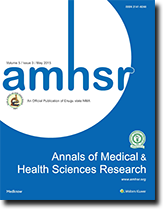

Basal Ganglia Calcification (BGC) is a rare radiological finding often associated with various neurological disorders, including Parkinsonism. Secondary hypoparathyroidism, characterized by insufficient Parathyroid Hormone (PTH) production, can lead to calcium imbalance and subsequent deposition in the basal ganglia, contributing to neurodegenerative symptoms. This condition presents with Parkinsonism features such as bradykinesia, rigidity and tremors. The interplay between low PTH levels and disturbed calcium homeostasis plays a key role in the pathogenesis of BGC and its neurological consequences. Early recognition and management of hypoparathyroidism are crucial to prevent further progression of Parkinsonian symptoms associated with basal ganglia calcification.
Select your language of interest to view the total content in your interested language
Annals of Medical and Health Sciences Research received 24805 citations as per google scholar report
 The Annals of Medical and Health Sciences Research is a monthly multidisciplinary medical journal.
The Annals of Medical and Health Sciences Research is a monthly multidisciplinary medical journal.